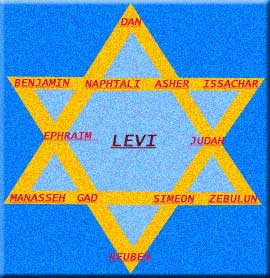
Dr. Gabriel H. Cohen from the Bible Department of Bar-Ilan University in Ramat Gan, Israel, wrote an article about Parashat Bemidbar which "is devoted to the array of the Israelites' encampment" . There were many ways in Jewish history to order the encampment of the tribes; Dr. Cohen mentions three of them and the third is:
"Jewish folklore describes the encampment of the tribes in the desert as forming a Star of David, twelve focal points being connected one to another, and all of these arranged around a central, thirteenth, focus--the Tabernacle and the tribe of Levi ministering the sacred service. A Yiddish anthology for the holidays describes the unique arrangement of the Israelite camp and its symbolism as follows:
According to this picture, the Star of David is the symbol of tribal unity in Israel, a single formation protecting the Sanctuary shared by all".
Photo is courtesy of the "project of Bar-Ilan University's Faculty of Jewish Studies, Paul and Helene Shulman Basic Jewish Studies Center, and the Office of the Campus Rabbi. Sponsored by Dr. Ruth Borchard of the Shoresh Charitable Fund (SCF). Published with assistance of the President's Fund for Torah and Science. Permission granted to reprint with appropriate credit".
Other examples are:
- the division of the people of Israel into Cohanim (priests), Levites and the common people. In our context it is noteworthy that this tripartite people of Israel is meant to function in and through its land. The latter is an entity which is symbolized by the number four. This may indicate that the people is in constant development within the frame of the established physical world;
- the division of the Temple into three sections, the Holy of Holies, the Hall of the Altars and the Public Court. Also here, these three sections are placed in the rectangular temple yard, indicating the idea expressed above (during the forty years of desert roaming, before the Temple was built in Jerusalem, the same idea was expressed by subdividing the 12 tribes into four times three tribes the latter being placed into the east, south, west, and north sides respectively of the camp);
- the division of functions in the Kingdom of Judea into that of King, Priest, and Prophet (which pre-figures Montesquieu's demand that a modern state should divide its powers between the legislative, administrative and executive branches);
- truth, freedom and love as the three pillars of a sound humanity.
All these form power fields on the social, political or spiritual level, and these fields could each be depicted by a triangle.
In this context, mention should be made of Hegel's triad of thesis-antithesis-synthesis, which gives the above discussion a philosophical dimension.
Referring back to the hydrogen atom and its different probability clouds, we can derive an interesting lesson from it for our human society. As all kind of possibilities are inherent in hydrogen atoms, including the six-lobed pattern which may eventually manifest as six-pointed snowflake crystals, likewise in human society. Descending from Adam, its common ancestor, its different ethnical, cultural etc groups can develop specific cultural and spiritual patterns, including the one characterized by the hexagram, or Star of David
In the following we will trace the width and depth of this symbol’s message as well as the influence it could and should exert on society for its well-functioning.
1 comment:
G.S. Oegema in his book Realms of Judaism, The history of the Shield of David, the birth of a symbol( Peter Lang, Germany, 1996, ISBN 3-631-30192-8) sums up Tulo Nussenblatt theory from 1938: "The hexagram when it is enclosed by a circle consists of twelve triangles, six outwardly and six inwardly directed, and in the middle a thirteens space. They correspond with the twelve tribes of Israel and the thirteenth tribe of Levi...It was the most effective way to defend the camp...from every side...
This summary sheds a little more light on the encampment theory that was brought earlier in this posting, which was also based on Nussenblatt's theory.
Post a Comment